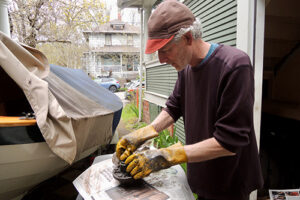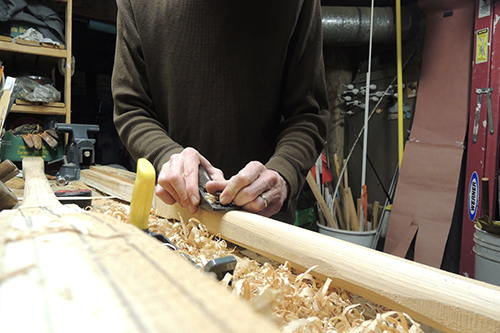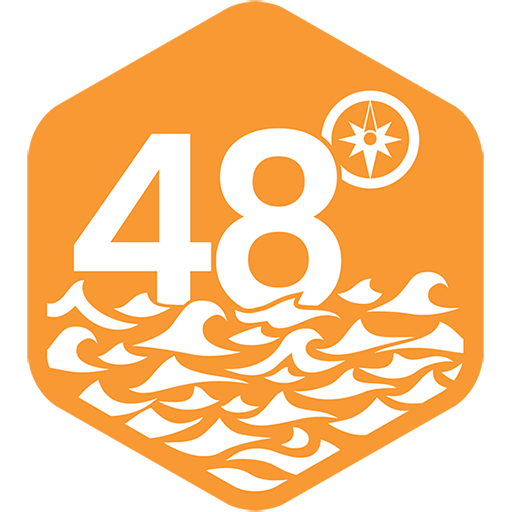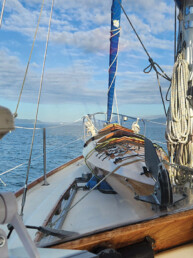
A neighbor stares up my driveway and his dubious look says it all, “What’s that boat-obsessed guy up to now?”
Most of my neighbors are used to the myriad projects that happen in my driveway or in the parking spaces in front of my house; either that, or they’re annoyed by the frequent comings and goings of my various craft, and the chores that go with them. With a fleet of small boats, there’s almost always something happening around my backyard boatyard, and I like it that way.
“No grease, no glory!” I call, hoisting a yellow rubber-gloved fist in the air. This particular job could have been offloaded to professionals at my local Les Schwab Tire Center for a hundred bucks and a lot less effort. But unlike diagnosing malfunctioning household appliances or climbing a 40-foot ladder to clean the second story gutters (an activity my wife has forbidden middle-aged me from doing) this is a project I can successfully complete.
The gloves are covered in a gloss of blue gray marine grease, as if I’ve just done surgery on a robot. Which in a way, I have. I’ve jacked up Row Bird’s trailer, unbolted the lug nuts on the wheel, disassembled the hub and bearings hidden below, and cleaned them of last year’s grease. Midway through the process of greasing the bearings and inner workings, I’ve made a substantial, but critical mess. For land-based sailors, keeping our trailer hubs adequately lubricated is crucial—if we omit this task, they’ll overheat and we’ll end up stuck on the side of the highway, smelling scorched metal instead of the tang of low tide. An hour later, the hub is reassembled, the wheels are back on, and the boat is ready to head to points north.
Another day, my quarry is those pesky registration letters required on the bow of most small boats. As an avid sketcher, I’m always doodling bubble letters in my notebook, so I decided that I had the skill to paint my own. Now I’m standing on a six-foot step ladder, paintbrush in hand, trying to create elegant white shapes that resemble letters on Luna’s red sheerstrake. Although I’ve penciled in each letter and neatly added blue masking tape to avoid unwanted smudges, a friend observing from a lawn chair cheekily informs me that my work is “a little too handmade.”

Climbing down for some perspective, I try to imagine the letters without the blue tape, and I have to admit they aren’t quite as crisp as I wanted them to be. For a moment, I start to wonder if perhaps I should have called a printshop and ordered some of the “nice” vinyl letters so common on boats these days. But in addition to the extra expense, I hesitate to slap machine-made lettering on a wooden boat made primarily by hand.
In the end, I decide to let the paint dry and evaluate. An hour later, surveying my work from 20 feet away, the letters are easily readable, yet still imperfect. But they meet the regulations, and they’re mine. Besides, Luna is already the wooden boat version of a Volkswagen bus; funky letters fit the bill. Another personal project is now complete. Next time I’ll do better.
I approached summer’s last project with a mix of trepidation and excitement. Using a kit, I’d built an ultralight dinghy for Luna, but oars weren’t part of the package. And I’m well aware that a good pair is the difference between rowing being a joy or a torment. The last time I tried making oars I had fun, but ended up with items resembling battle axes, rather than well-balanced rowing devices. Still, I reasoned that oars for a dinghy didn’t require the skills of a master craftsman. After all, dinghies end up being bashed around at the dock and things in them sometimes go missing. So rather than buying a cheap heavy pair at the marine store, or an expensive, beautiful pair I’d worry about, I decided to make them myself using lumberyard cedar.
After digging through nearly 100 two by fours, I found a handful that were mostly knot free. With the help of a friend, we ran them through a planer and used epoxy to glue them together to make the shafts of the oars. Over many evenings and weekend afternoons, I employed a band saw, a spokeshave, and a series of planes to turn all that wood into a pair of oars that now moves my dinghy along comfortably. Using them, I remember the joy of seeing something attractive and useful emerge from raw materials.
The completion of the dinghy and oars gave me a sense of accomplishment larger than any of my past nautical projects. But I couldn’t find the words to describe that feeling until I read a post from my friend Alex at the WoodenBoat Forum.

“There are few opportunities in this increasingly virtual and manufactured world to do something truly authentic, and end up with something unique. To do something that is, to me, a perfect fusion of action and contemplation, of doing and being. To undertake a protracted project that engages your intellect, yet allows you to be in the moment, for extended periods.”
Alex got it exactly right. When I take my boat to a shop, or to someone else for repairs, it’s all out of my hands. Maybe my neighbors don’t get it, but whether I’m doing a simple job on my boat or a more complex task, I’m fully engaged in an activity that feels important, helps me learn new things, or makes me relish skills I’ve developed. That’s nearly as good as being out on the water.
Bruce Bateau sails and rows traditional boats with a modern twist in Portland, Oregon. His stories and adventures can be found at www.terrapintales.wordpress.com
Bruce Bateau
Bruce Bateau sails and rows traditional boats with a modern twist in Portland, Ore. His stories and adventures can be found at www.terrapintales.wordpress.com






